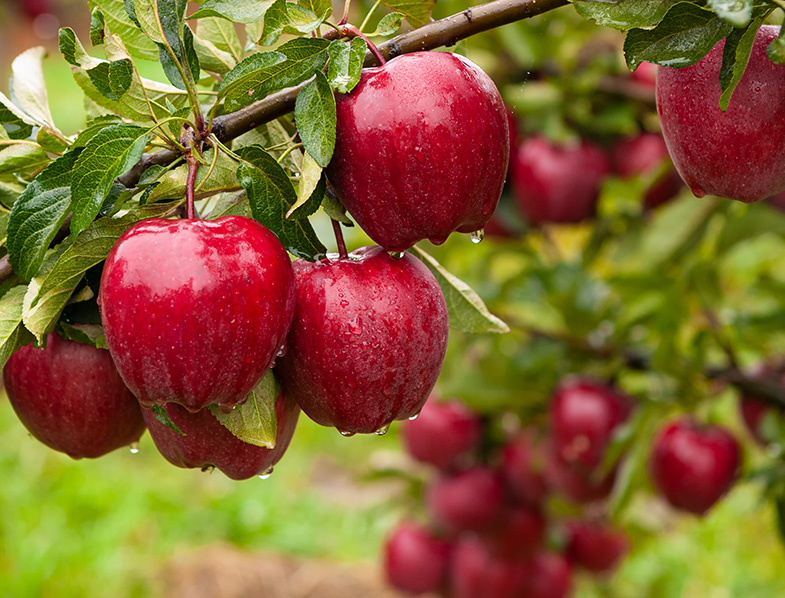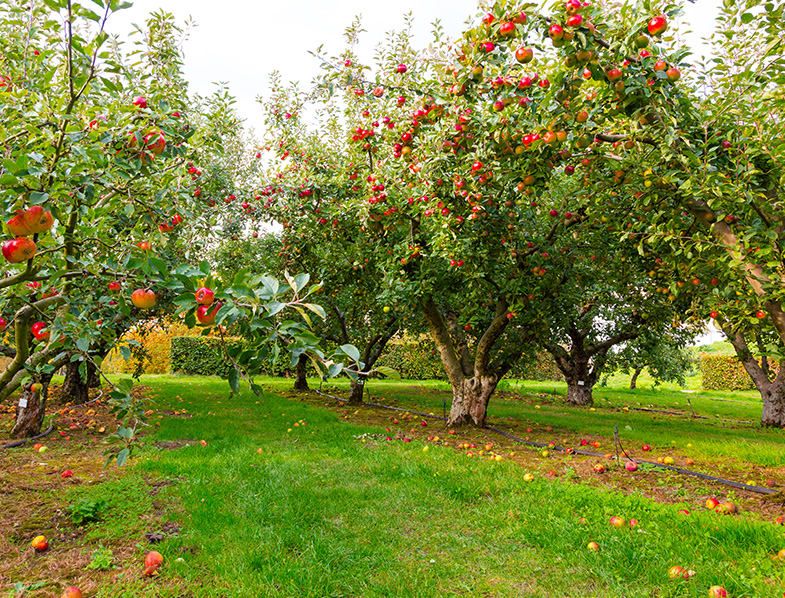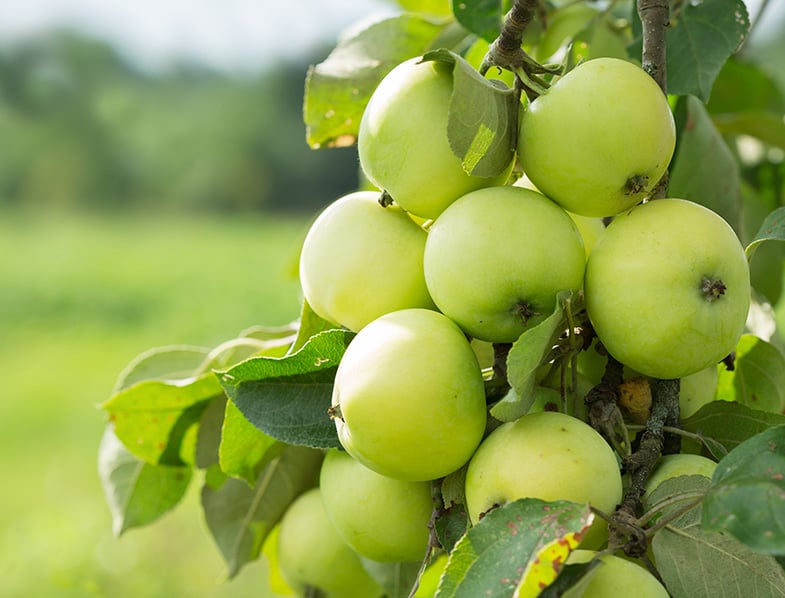Apple trees are a beautiful addition to any garden and provide fresh, delicious fruit every year. Whether you’re an experienced gardener or just starting out, growing apple trees can seem daunting. But fear not! With these simple tips, you can successfully grow and care for your own apple tree.
Quick Facts
| Topic | Information |
|---|---|
| Choosing the Variety | Consider climate, growing conditions, size, and apple use when selecting an apple tree variety. |
| Popular Varieties | Gala (eating fresh), Granny Smith (cooking), Honeycrisp (eating fresh, cider), Red Delicious (eating) |
| Climate Considerations | Choose heat-tolerant or cold-hardy varieties based on your local climate and rainfall conditions. |
| Pollination Requirements | Most apple trees require cross-pollination, while some are self-pollinating. |
| Planting | Select a sunny location with well-draining soil. Prepare the soil, dig a proper hole, and water well. |
| Caring for Your Tree | Regular watering, fertilization, pruning, and pest control are essential for the tree’s health. |
| Harvesting and Storing | Harvest apples when ripe, using proper techniques. Store in a cool, dry place with good ventilation. |
Choosing the Right Apple Tree Variety
When choosing which apple tree variety to plant in your garden, there are a few important factors to consider. Firstly, consider your climate and growing conditions. Different apple tree varieties require different amounts of sun and water, so make sure you choose a variety that suits your growing environment.
Another factor to consider is the size of the tree. Some apple tree varieties grow to be quite large, while others are more compact. If you have limited space in your garden, a more compact variety may be a better choice.
It’s also important to think about what you want to use the apples for. Some varieties are better for eating fresh, while others are better for cooking or making cider.
Popular Apple Tree Varieties
Some of the most popular apple tree varieties include:
- Gala: A sweet and crisp apple that is great for eating fresh.
- Granny Smith: A tart apple that is perfect for baking and cooking.
- Honeycrisp: A juicy and sweet apple that is great for eating fresh or making cider.
- Red Delicious: A classic apple with a sweet flavor that is great for eating fresh or in salads.
Climate Considerations
Consider your local climate when deciding on which apple tree variety to plant. For example, if you live in a warm climate, you may want to choose a variety that is more heat-tolerant, such as the Gala variety. On the other hand, if you live in a cooler climate, you may want to choose a variety that is more cold-hardy, such as the Granny Smith variety.
It’s also important to consider the amount of rainfall in your area. Some apple tree varieties require more water than others, so make sure you choose a variety that can thrive in your local conditions.
Pollination Requirements
Most apple tree varieties require cross-pollination with another variety in order to produce fruit. Make sure you choose apple tree varieties that are compatible with each other, and plant them close enough together for the bees to visit both varieties. Some apple tree varieties are self-pollinating, meaning they do not require another variety to produce fruit. If you only have space for one tree, consider choosing a self-pollinating variety such as the Golden Delicious.
By considering these factors when choosing which apple tree variety to plant, you can ensure that you choose a tree that will thrive in your garden and provide you with delicious fruit for years to come.

Planting Your Apple Tree
Once you’ve chosen the right apple tree variety, it’s time to plant your tree. But before you do, it’s important to know a few things about planting apple trees.
Apple trees are a great addition to any garden, providing delicious fruit for years to come. They are relatively easy to grow, but require some care and attention to ensure they thrive.
Selecting the Ideal Location
Choosing the right location for your apple tree is crucial. Apple trees need plenty of sun to grow and produce fruit, so choose a location in your garden that gets at least 6 hours of direct sunlight each day.
It’s also important to choose a location with well-draining soil. Apple trees don’t like wet feet and can suffer from root rot if planted in soil that doesn’t drain well. Avoid planting your apple tree in low-lying areas where water may collect, or in areas that are prone to frost.
Preparing the Soil
Before planting your apple tree, it’s important to prepare the soil. Apple trees prefer soil that is rich in nutrients and well-draining.
Start by digging a hole that is twice the size of the tree’s root ball. This will give the roots plenty of room to spread out and grow.
Next, add compost or well-rotted manure to the soil to provide additional nutrients. This will help your apple tree get off to a good start and encourage healthy growth.
Planting Techniques and Tips
When planting your apple tree, make sure the tree’s root ball is level with the soil. If the tree is planted too deep, it can suffocate and die.
Water the tree thoroughly after planting, and add a layer of mulch around the base to help retain moisture. This will help the tree establish itself and reduce the amount of watering needed in the future.
It’s also a good idea to stake your apple tree to help keep it upright until it establishes a strong root system.
With a little care and attention, your apple tree will grow strong and healthy, providing delicious fruit for years to come.

Caring for Your Apple Tree
Apple trees are a beautiful addition to any garden or orchard. Not only do they provide shade and beauty, but they also produce delicious fruit that can be enjoyed for years to come. However, like any living thing, apple trees require proper care and attention to thrive. Here are some tips on how to care for your apple tree:
Watering and Irrigation
Water is essential for any plant to grow, and apple trees are no exception. During the summer months, it’s important to water your apple tree regularly to keep the soil moist. However, be careful not to overwater your tree, as this can lead to root rot. To ensure your apple tree gets the right amount of water, check the soil regularly and water it when the top inch of soil feels dry to the touch.
Fertilization and Soil Amendments
Apple trees require regular fertilization to keep them healthy and productive. In early spring and mid-summer, apply a balanced fertilizer to your tree to provide it with the nutrients it needs to grow and produce fruit. You can also consider adding soil amendments such as bone meal or blood meal to enrich the soil and improve its overall health.
Pruning and Training
Pruning is an important part of apple tree care, as it helps to promote good growth and fruit production. In late winter or early spring, when the tree is dormant, prune your apple tree by removing any dead, damaged or diseased branches. You should also thin out the canopy to allow for proper air flow and sunlight. Training your apple tree by shaping it into a desirable form can also help to improve its overall health and productivity.
Pest and Disease Management
Apple trees are susceptible to a variety of pests and diseases, including apple maggots, codling moths, and powdery mildew. To keep your tree healthy and free of pests, implement a regular pest and disease management plan. This can include using organic pesticides, practicing good hygiene, and removing any infected plant material.
By following these tips, you can ensure that your apple tree stays healthy and productive for years to come. With a little care and attention, your tree will provide you with delicious fruit and beauty for many seasons.
Harvesting and Storing Apples
When to Harvest Apples
Apples are a delicious fruit that can be enjoyed in many different ways. Whether you like them fresh, baked, or in a pie, there’s nothing quite like the taste of a home-grown apple. But when is the best time to harvest your apples?
The answer depends on the variety of apple tree you have. Some apples are ready for harvest in late summer, while others may not be ready until early autumn. You can tell when an apple is ready for harvest by looking at its color and firmness. A ripe apple will be its characteristic color, and it will feel firm to the touch.
It’s important to harvest your apples at the right time to ensure they are as flavorful and nutritious as possible. If you wait too long to harvest, the apples may become overripe and mushy, which can affect their taste and texture.
Proper Harvesting Techniques
Once you’ve determined that your apples are ready for harvest, it’s time to pick them. Proper harvesting techniques are important to ensure that your apples stay fresh and flavorful for as long as possible.
To harvest your apples, gently twist each apple until it releases from the tree. Be careful not to pull too hard, as this can damage the apple or the tree. Handle the apples carefully to avoid bruising, and place them in a basket or box lined with soft material, such as a towel or newspaper.
It’s important to harvest your apples by hand rather than using a machine, as machines can damage the tree and the fruit.
Storing Apples for Longevity
Once you’ve harvested your apples, it’s important to store them properly to ensure they stay fresh for as long as possible.
The ideal storage location for apples is a cool, dry place with good ventilation. A basement or garage can be a good option, as long as the temperature stays between 30 and 40 degrees Fahrenheit.
Avoid storing your apples near other fruits or vegetables that produce ethylene gas, as this can cause the apples to ripen too quickly. You can also store your apples in a refrigerator, but be sure to keep them away from foods with strong odors, as apples can absorb these odors and affect their flavor.

Conclusion
By following these simple tips, you can successfully grow and care for your own apple tree, and enjoy delicious, home-grown fruit for years to come. Whether you’re making a pie, baking a cake, or simply enjoying a fresh apple, there’s nothing quite like the taste of a home-grown apple.
Apple Tree FAQS
How long does it take for an apple tree to bear fruit?
The time it takes for an apple tree to bear fruit varies depending on the tree’s age and the variety you choose. In general, apple trees typically start producing fruit within 3 to 5 years after planting.
Are apple trees easy to grow?
Apple trees can be moderately challenging to grow but are still suitable for both experienced gardeners and beginners. They require proper care, including regular watering, pruning, and pest control. With attention to their needs, apple trees can thrive in a home garden.
Do you need 2 apple trees to produce fruit?
Not necessarily. While some apple tree varieties are self-pollinating, meaning they can produce fruit on their own, many varieties benefit from cross-pollination to ensure optimal fruit production. To increase your chances of a fruitful harvest, it is recommended to plant at least two different apple tree varieties that bloom around the same time, facilitating cross-pollination.
How long does an apple tree take to grow?
The time it takes for an apple tree to reach its full size depends on various factors, including the variety and growing conditions. On average, it can take anywhere from 6 to 10 years for an apple tree to reach maturity and its maximum height. However, apple trees start producing fruit within a few years of planting.
How much water do apples need?
Apples require consistent watering, especially during dry periods. A general guideline is to provide your apple tree with about 1 to 1.5 inches (2.5 to 3.8 cm) of water per week. However, it’s important to monitor the soil moisture and adjust the watering accordingly based on factors such as temperature, rainfall, and soil drainage.
What is the quickest fruit to grow?
The quickest fruit to grow depends on various factors, including the type of fruit, growing conditions, and cultivation techniques. Some fruits that are generally known for their relatively fast growth and quick yield include strawberries, raspberries, blackberries, and certain types of melons. These fruits often produce harvestable yields within a few months of planting.
